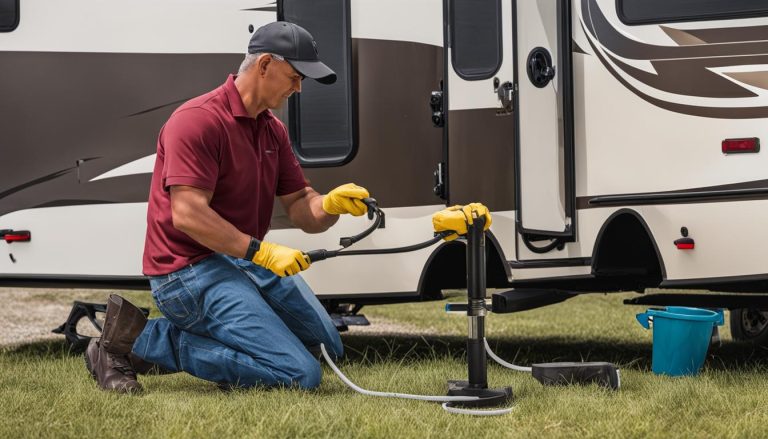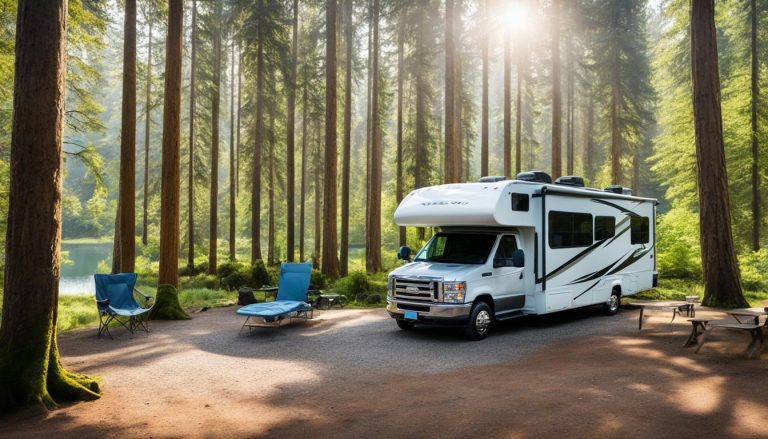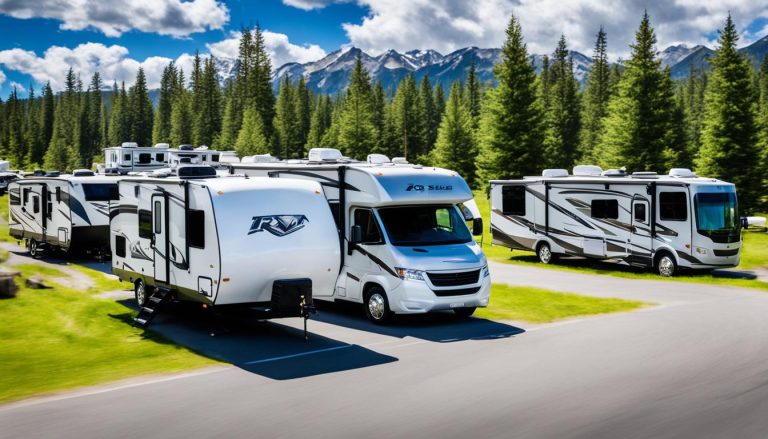RV Water Tank Cleaning Guide – Quick & Simple!
gorvlifestyle.com and its partners may earn a commission if you purchase a product through one of our links
Keeping your RV’s water tank clean is essential for maintaining hygiene on your camping trips. Regular cleaning of your fresh water tank ensures that you have safe and clean water for drinking, showering, and washing dishes. In this guide, we will provide you with a step-by-step process to effectively clean your RV’s water tank.
Key Takeaways:
- Regularly cleaning your RV’s water tank is crucial for ensuring a safe and clean water supply.
- Follow a step-by-step guide to effectively clean your RV’s water tank.
- Consider using household bleach or an RV tank sanitizer to efficiently clean your water tank.
- Maintain your water tank by practicing good RV water tank maintenance habits.
- Remember to clean your water tank at least once a year, or more frequently as needed, to enjoy fresh and safe water on all your camping adventures.
How Often Should You Clean Your RV Water Tank?
When it comes to maintaining the cleanliness and safety of your RV’s water supply, regular cleaning of the water tank is key. Most RVers choose to clean their RV water tanks at least once a year as part of their spring dewinterizing routine. But how often should you really clean your RV water tank?
If your RV has been sitting unused for 2-4 weeks, it is highly recommended to sanitize the water tank before using it again. This precaution ensures that any stagnant water or potential contaminants are eliminated, providing you with clean and safe water for your travels.
Cleaning the tank every 6 months is a best practice that many seasoned RVers follow. However, it’s important to note that the cleaning frequency may vary depending on your specific circumstances. If you frequently use your RV or if you notice any signs of impurities or odor in your water, it’s a good idea to clean your water tank more frequently.
Keeping a regular cleaning schedule for your RV water tank will not only help maintain the quality of your water supply but also prevent the buildup of sediment and bacteria that can compromise your health and the performance of your RV’s plumbing system.
Additional Tips for Maintaining a Clean RV Water Tank:
- Use a designated hose for filling your RV’s water tank to prevent cross-contamination.
- Regularly inspect the tank for any signs of leaks, corrosion, or damage.
- Flush out the tank with fresh water before each trip to remove any residual cleaning agents.
- Consider using RV-specific tank cleaning products for a more thorough cleaning.
- Keep the water tank vent covered to prevent debris and insects from entering.
- If possible, avoid storing water in the tank for extended periods when not in use.
By following these tips and maintaining a regular cleaning schedule, you can ensure that your RV’s water tank remains clean, safe, and ready for your next adventure.
How to Clean Your RV Water Tank – Step by Step Guide
Cleaning your RV water tank is an important task to ensure the cleanliness and safety of your water supply. Whether you prefer using household bleach or an RV tank sanitizer, here is a step-by-step guide to help you effectively clean your RV water tank:
- Prepare for cleaning: Start by turning off the water supply to your RV and draining any remaining water from the tank. This can be done by opening the drain valve or using the water pump to empty the tank.
- Mix the cleaning solution: If you choose to use bleach, mix 1/4 cup of bleach for every 15 gallons of water capacity in your tank. For an RV tank sanitizer, follow the instructions provided on the product packaging.
- Fill the water tank: Use a hose or other suitable method to fill the water tank with the cleaning solution. Make sure to fill it to its maximum capacity.
- Circulate the cleaning solution: Turn on the water pump and open each faucet, one at a time, including the shower and any outdoor faucets. Let the cleaning solution flow through the pipes and faucets for a few minutes to ensure thorough cleaning.
- Let it sit: Once the cleaning solution has circulated through the system, close all faucets and leave the solution in the tank for at least 12 hours. This will allow the bleach or sanitizer to effectively kill any bacteria or contaminants.
- Drain and rinse: After the recommended time has passed, open all faucets and drain the tank completely. Flush the system with fresh water by filling the tank and running water through all faucets until the water runs clear.
- Repeat if necessary: If you notice any lingering odor or discoloration, repeat the cleaning process until the water is odorless and clear.
Following these steps will help you maintain a clean and safe water tank in your RV. Remember to always refer to your RV manufacturer’s guidelines and consult the product instructions for any specific cleaning recommendations.
Tips for Effective RV Water Tank Cleaning
- Regular maintenance: Clean your RV water tank at least once a year, or more frequently if needed. This will help prevent the buildup of bacteria and ensure the longevity of your water tank.
- Use RV-specific products: Look for cleaning products that are specifically designed for RV water tanks. These products are formulated to effectively clean and sanitize RV water systems without causing damage.
- Flush the system before use: After cleaning, make sure to thoroughly flush your RV water system with fresh water before using it for drinking, showering, or cooking.
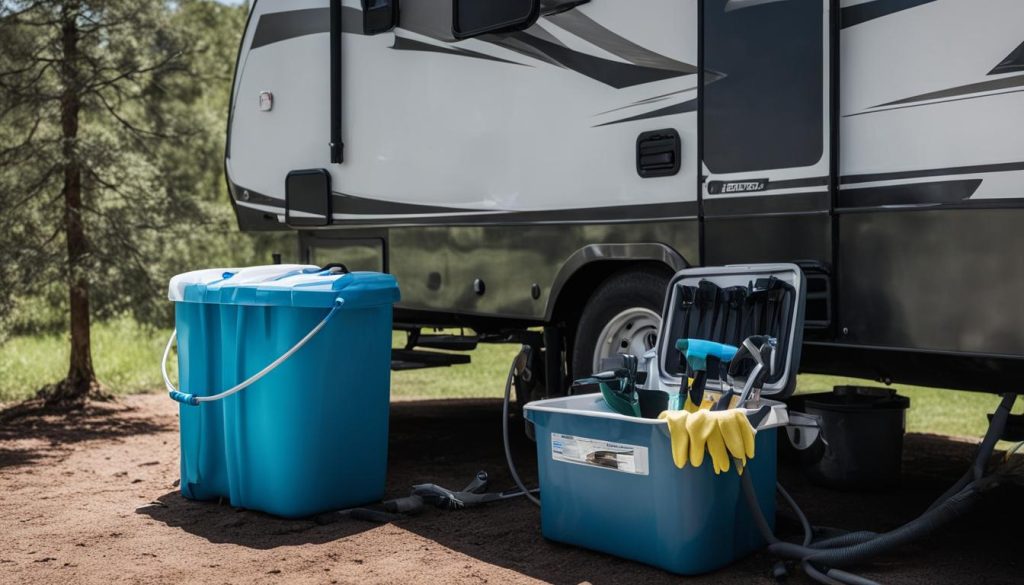
| Product | Description |
|---|---|
| 1. RV Water Tank Cleaner | A specially formulated cleaner that effectively removes bacteria, mold, and residue from RV water tanks. |
| 2. Bleach | Household bleach can be used as an alternative to RV-specific cleaners. Follow the recommended bleach-to-water ratio for safe and effective cleaning. |
| 3. RV Tank Sanitizer | An easy-to-use sanitizer that kills bacteria, viruses, and other harmful contaminants in RV water tanks. |
By following the best practices for cleaning your RV water tank and using the right products, you can ensure a clean and safe water supply for your camping adventures.
Additional Tips for RV Water Tank Cleaning
Maintaining a clean and sanitized RV water tank is crucial for the overall health and safety of your camping adventures. In addition to following the step-by-step guide provided earlier, here are some additional tips to help you keep your RV water tank pristine:
1. Regular Inspection
Regularly inspect your RV’s water tank for any signs of damage or contamination. Look for cracks, leaks, or discoloration that may indicate a problem. If you notice any issues, address them promptly to prevent further damage.
2. Use RV-Safe Cleaning Products
When cleaning your RV water tank, it’s important to use products specifically designed for this purpose. Avoid using harsh chemicals or household cleaners that may leave residue or damage the tank’s surfaces. Opt for RV-safe cleaning agents and sanitizers to ensure optimal cleanliness and safety.
3. Proper Ventilation
Ensure that your RV’s water tank has proper ventilation to prevent the growth of bacteria and mold. Keep the tank’s access panels open when not in use to allow for air circulation. Additionally, consider installing vent fans or vents to enhance airflow and minimize the risk of contamination.
4. Regular Flushing
Flushing your water tank regularly is key to preventing buildup of sediment, debris, and bacteria. Before each trip, flush the tank with fresh water to remove any contaminants. Additionally, drain and flush the tank after every outing to maintain its cleanliness and extend its lifespan.
5. Avoid Stagnant Water
Stagnant water can lead to foul odors and the growth of bacteria. To prevent this, use your RV’s water supply regularly and avoid leaving water sitting unused in the tank for extended periods. Consider adding a water treatment solution or an RV water tank cleaner to inhibit the growth of microorganisms.
| TIP | DESCRIPTION |
|---|---|
| Tip #1 | Regularly inspect your RV’s water tank for damage or contamination. |
| Tip #2 | Use RV-safe cleaning products to ensure optimal cleanliness and safety. |
| Tip #3 | Ensure proper ventilation of the water tank to prevent bacterial growth. |
| Tip #4 | Regularly flush the water tank to remove sediment and debris. |
| Tip #5 | Avoid stagnant water by using the RV’s water supply regularly. |
By incorporating these additional tips into your RV water tank maintenance routine, you can enjoy a clean and safe water supply throughout all your camping adventures.
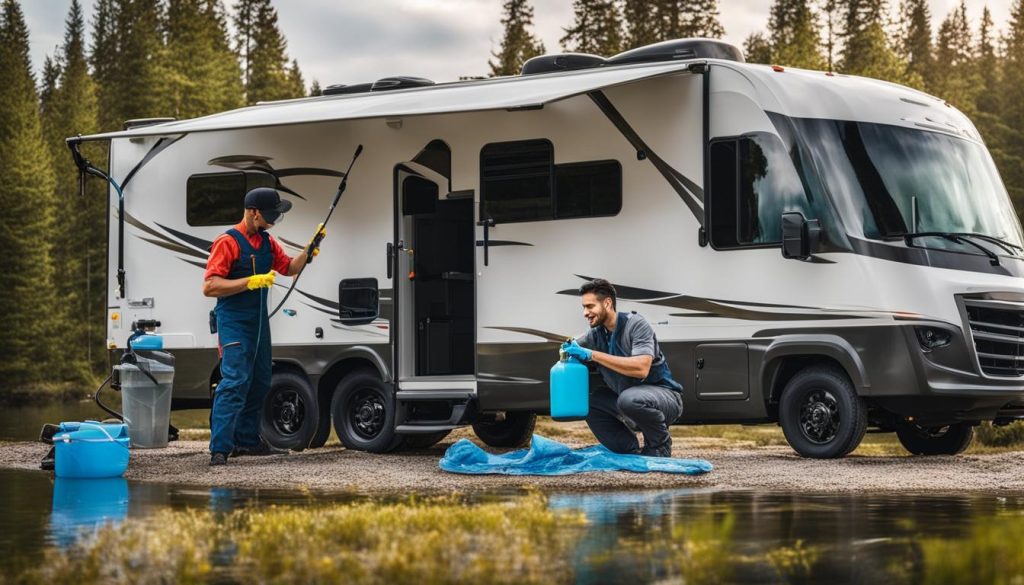
Conclusion
Regularly cleaning and sanitizing your RV’s water tank is crucial for ensuring the safety and cleanliness of your water supply. By following the step-by-step guide and implementing the additional tips provided in this article, you can easily maintain a clean and hygienic water system in your RV. Remember to clean your water tank at least once a year, or more frequently as needed, to enjoy fresh and safe water on all your camping adventures.
FAQ
How often should I clean my RV water tank?
It is recommended to clean your RV water tank at least once a year, or more frequently if your RV has been unused for 2-4 weeks.
What is the best way to clean an RV water tank?
You can clean your RV water tank using household bleach or an RV tank sanitizer. Follow our step-by-step guide for effective cleaning.
Can I use household bleach to clean my RV water tank?
Yes, household bleach can be used to clean your RV water tank. Make sure to follow the proper ratios and instructions provided in our step-by-step guide.
Are there any specific products I can use to clean my RV water tank?
Yes, there are specific RV tank sanitizers available in the market that are designed to effectively clean and sanitize your RV water tank. These products can be used as an alternative to household bleach.
How long does it take to clean an RV water tank?
The time it takes to clean an RV water tank can vary depending on the size of the tank and the method used. Generally, it takes around 30-60 minutes to complete the cleaning process.
What are some additional tips for maintaining a clean RV water tank?
To maintain a clean RV water tank, you should regularly flush and sanitize the tank, use a water filter to prevent contamination, and ensure proper storage of your RV to avoid bacteria growth in the tank.

